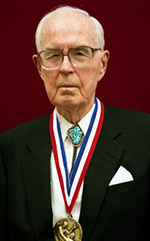About
In Memoriam: Willis Lamb Jr.,
May 15, 2008
OSA Mourns the Loss of Nobel Laureate Willis Lamb Jr.
 Professor Emeritus Willis E. Lamb, Jr., a Nobel Laureate and OSA Honorary Member, died May 15, 2008. He was 94 years old.
Professor Emeritus Willis E. Lamb, Jr., a Nobel Laureate and OSA Honorary Member, died May 15, 2008. He was 94 years old.
Lamb received a Nobel Prize in 1955 for his experimental work on the fine structure of the hydrogen spectrum and discovery of a phenomenon called the Lamb shift. His discovery revolutionized the quantum theory of matter and led physicists to rethink the basic concepts behind the application of quantum theory to electromagnetism. Lamb’s work became one of the foundations of quantum electrodynamics, a key aspect of modern elementary particle physics.
Lamb was elected to Honorary Membership, OSA’s highest honor, in 2000, in recognition of his work in quantum mechanics and the study of the interaction of radiation and matter, including the theory of lasers.
Lamb earned a bachelor's degree in chemistry from the University of California at Berkeley in 1934. He continued at Berkeley as a graduate student in theoretical physics. His thesis research was directed by J. Robert Oppenheimer, an extraordinary teacher and theoretician who in 1942 was appointed by President Roosevelt to head the Manhattan Project that created the atomic bomb. Lamb was awarded his doctoral degree in 1938 for his dissertation on the electromagnetic properties of nuclear systems.
He joined the Columbia University physics faculty in 1938. From 1943 to 1951, he worked with the Columbia Radiation Laboratory. There his defense-related research focused on the problem of how to make shorter, higher -frequency microwave sources for radar. In the summer of 1946 Lamb conceived a difficult experiment to study the fine structure of optical radiation from hydrogen with very high resolution radio frequency resonance methods. In 1947, his experiment succeeded, revealing the minute but significant shift of energy in the hydrogen atom in different states. Two months later, Lamb was invited to present his work at a historically famous conference on Shelter Island, New York, a conference subsidized by the National Academy of Sciences to explore directions for research in the post-war era.
Lamb's published theoretical research anticipated the discovery of the maser (a device to generate coherent microwave radiation from excited atoms or molecules) and its optical counterpart, the laser. Although he did not invent these devices, he made pioneering contributions to their theoretical understanding and the subject of quantum optics. Theodore Maiman, who was the first to actually construct a laser, was Lamb's student at Stanford.
Lamb continued working in the general area of atomic spectroscopy and theoretical laser physics as a member of the Stanford University faculty (1951-56) and as professor and Fellow of New College at the University of Oxford, England (1956-62). At Yale University, Lamb was Henry Ford II Professor of Physics (1962-72) and J. Willard Gibbs Professor of Physics (1972-74.)
Dr. Lamb joined the University of Arizona Optical Sciences Center in 1974. He was named Regents’ Professor of physics and optical sciences in 1990 and retired in 2002. Recently, Professor Lamb and friends established the Willis Lamb, Jr. Scholarship in Optical Sciences as a legacy to “all who pursue their passions and endeavors to discover great things.” The scholarship was awarded for the first time a few weeks before his death.
Lamb was awarded the 2000 National Medal of Science, the nation’s highest scientific honor, for “his towering contributions to classical and quantum theories of laser radiation and quantum optics, and to the proper interpretation of non-relativistic quantum mechanics.” He was the recipient of numerous other honors and awards, including the 1992 Einstein Medal given by the Society for Optical and Quantum Electronics and the Guthrie Award from the Physical Society of London. He was elected to the National Academy of Sciences and was a Fellow of the American Physical Society as well as a Foreign Member of the Royal Society of Edinburgh. Lamb held honorary degrees from the University of Pennsylvania, Oxford University, Yale University, Yeshiva University, Gustavus Adolphus College and Columbia University. In 1998, he was honored by the creation of the Willis E. Lamb Award for Laser Science and Quantum Optics, presented annually for outstanding contributions to the field.
Dr. Lamb is survived by his wife, Elsie Wattson Lamb.
